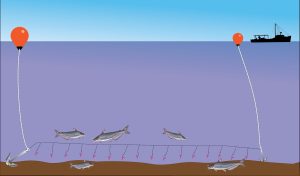Initiatives will trial ideas aimed at increasing invasive catfish removals in the Chesapeake Bay

Waterman David “Cornflower” Confair fishing for invasive blue catfish on Marshyhope Creek. Maryland DNR photo by Stephen Badger.
The Maryland Department of Natural Resources (DNR) is launching two pilot programs in coordination with its Invasive Catfish Advisory Committee aimed at curbing the spread of blue catfish in the Chesapeake Bay and its tributaries.
Applications are now open for the Blue Catfish For-Hire/Commercial and Mid- and Lower-Bay Finfish Trotline Pilot Programs. Commercial watermen and charter boat captains can apply to participate through online forms on the DNR website.
“The silver lining to the challenges blue catfish pose in the Chesapeake Bay is they taste great,” said DNR Invasive Fishes Program Manager Branson Williams. “These pilot programs aim to reduce barriers for commercial fishermen to catch and sell more blue catfish. Our goal is to reduce biomass, and these programs will help with those efforts.”
Blue catfish – Ictalurus furcatus – are problematic due to their voracious and indiscriminate appetites, high reproductive rate, and potential to harm native species, some of which are commercially and recreationally important to Maryland, including blue crabs.
The pilot programs are part of a larger effort by the department to mitigate the negative impact blue catfish have on native species and ecosystems. Other initiatives include incentivizing charter captains to gather harvest data on their catfish and Chesapeake Channa (northern snakehead) trips, supporting invasive species tournaments, and working with stakeholders and other agencies to increase removals. There is no season or limit on recreational blue catfishing for anglers holding the appropriate Maryland fishing license.
Details of the two new programs are below.
Blue Catfish For-Hire/Commercial Pilot Program
The Blue Catfish Charter Pilot Program allows participants to run for-hire and commercial fishing trips simultaneously and removes crew limits on commercial hook-and-line fishing trips that target blue catfish. This action will financially incentivize captains to sell excess blue catfish after a charter rather than releasing the fish alive.
There is no maximum number of pilot participants for this project. Applicants must hold an appropriate commercial fishing license, target blue catfish on the charter trip, and complete daily reporting for the charter trip and commercial activity.
Applications for the program are open now and will be reviewed on a rolling basis.
Mid- and Lower-Bay Finfish Trotline Pilot Program
The department is considering relaxing regulations prohibiting finfish trotlines south of the William Preston Lane Jr. Memorial (Bay) Bridge to combat increased abundance and expanded distribution of invasive catfishes through additional commercial harvest.

Maryland DNR image
The Mid- and Lower-Bay Finfish Trotline Pilot Program will allow a small number of harvesters to use finfish trotlines (see illustration) in the mainstem Chesapeake Bay south of the Bay Bridge. The department will examine bycatch, user conflicts, and other issues encountered during the pilot before proposing regulation changes to allow widespread use.
Finfish trotlines are an effective gear commonly used to harvest invasive blue and flathead catfish (Pylodictis olivaris). Trotlines accounted for 26% of Maryland’s blue catfish harvest from 2019 through 2023.
Program participants must possess a Maryland Unlimited Tidal Fish License (TFL) or Unlimited Finfish Harvester License (FIN). All harvest must be reported after each trip via an electronic reporting form or logbook provided by the department.
Current license holders can still use finfish trotlines to harvest blue catfish and other fish in legal waters of the state without participating in this program.
Applications are open now through February 20, 2025. A limited number of permits will be issued based on weighted selection criteria.
